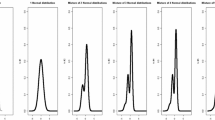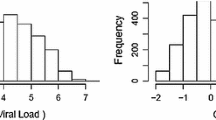Abstract
Linear mixed models are traditionally used for jointly modeling (multivariate) longitudinal outcomes and event-time(s). However, when the outcomes are non-Gaussian a quantile regression model is more appropriate. In addition, in the presence of some time-varying covariates, it might be of interest to see how the effects of different covariates vary from one quantile level (of outcomes) to the other, and consequently how the event-time changes across different quantiles. For such analyses linear quantile mixed models can be used, and an efficient computational algorithm can be developed. We analyze a dataset from the Acute Lymphocytic Leukemia (ALL) maintenance study conducted by Tata Medical Center, Kolkata. In this study, the patients suffering from ALL were treated with two standard drugs (6MP and MTx) for the first two years, and three biomarkers (e.g. lymphocyte count, neutrophil count and platelet count) were longitudinally measured. After treatment the patients were followed nearly for the next three years, and the relapse-time (if any) for each patient was recorded. For this dataset we develop a Bayesian quantile joint model for the three longitudinal biomarkers and time-to-relapse. We consider an Asymmetric Laplace Distribution (ALD) for each outcome, and exploit the mixture representation of the ALD for developing a Gibbs sampler algorithm to estimate the regression coefficients. Our proposed model allows different quantile levels for different biomarkers, but still simultaneously estimates the regression coefficients corresponding to a particular quantile combination. We infer that a higher lymphocyte count accelerates the chance of a relapse while a higher neutrophil count and a higher platelet count (jointly) reduce it. Also, we infer that across (almost) all quantiles 6MP reduces the lymphocyte count, while MTx increases the neutrophil count. Simulation studies are performed to assess the effectiveness of the proposed approach.





Similar content being viewed by others
References
Alfó M, Marino MF, Ranalli MG, Salvati N, Tzavidis N (2021) M-quantile regression for multivariate longitudinal data with an application to the Millennium Cohort Study. J R Stat Soc Ser C Appl Stat 70:122–146
Arora RS, Arora B (2016) Acute leukemia in children: a review of the current Indian data. South Asian J Cancer 5:155
Biswas J, Das K (2021) A Bayesian quantile regression approach to multivariate semi-continuous longitudinal data. Comput Stat 36:241–260
Biswas J, Ghosh P, Das K (2020) A semi-parametric quantile regression approach to longitudinal outcomes with zero inflation and incompleteness. Adv Stat Anal 104:261–283
Brooks SP, Gelman A (1998) General methods for monitoring convergence of iterative simulations. J Comput Graph Stat 7:434–455
Das K (2016) A semiparametric Bayesian approach for joint modeling of longitudinal trait and event time. J Appl Stat 43:2850–2865
Das K, Daniels MJ (2014) A semiparametric approach to simultaneous covariance estimation for bivariate sparse longitudinal data. Biometrics 70:33–43
Farcomeni A, Viviani S (2015) Longitudinal quantile regression in the presence of informative dropout through longitudinal-survival joint modelling. Stat Med 34:1199–1213
Fieuws S, Verbeke G (2004) Joint modelling of multivariate longitudinal profiles: Pitfalls of the random-effect approach. Stat Med 23:3093–3104
Geraci M, Bottai M (2007) Quantile regression for longitudinal data using the asymmetric Laplace distribution. Biostatistics 8:140–154
Guo X, Carlin BP (2004) Separate and joint modeling of longitudinal and event time data using standard computer packages. Am Stat 58:16–24
Henderson R, Diggle P, Dobson A (2000) Joint modelling of longitudinal measurements and event time data. Biostatistics 1:465–480
Koenker R, Bassett G Jr (1978) Regression quantiles. Econom J Econom Soc 46:33–50
Koenker R (2004) Quantile regression for longitudinal data. J Multivar Anal 91:74–89
Kozumi H, Kobayashi G (2011) Gibbs sampling methods for Bayesian quantile regression. J Stat Comput Simul 81:1565–1578
Kulkarni H, Biswas J, Das K (2019) A joint quantile regression model for multiple longitudinal outcomes. Adv Stat Anal 103:453–473
Kundu D, Sarkar P, Gogoi M, Das K (2024) A Bayesian joint model for multivariate longitudinal and time-to-event data with application to aLL maintenance studies. J Biopharm Stat 34:37–54
Picchini U, Gaetano AD, Ditlevsen S (2010) Stochastic differential mixed-effects models. Scand J Stat 37:67–90
Pui CH, Evans WE (2013) A 50-year journey to cure childhood acute lymphoblastic leukemia. Semin Hematol 50:185–196
Pui CH, Yang JJ, Bhakta N, Rodriguez-Galindo C (2018) Global efforts toward the cure of childhood acute lymphoblastic leukaemia. Lancet Child Adolesc Health 2:440–454
Rizopoulos D, Ghosh P (2011) A Bayesian semiparametric multivariate joint model for multiple longitudinal outcomes and a time-to-event. Stat Med 30:1366–1380
Rizopoulos D (2016) The R package JMbayes for fitting joint models for longitudinal and time-to-event data using MCMC. J Stat Softw 72:1–45
Rizopoulos D, Molenberghs G, Lesaffre E (2017) Dynamic predictions with time-dependent covariates in survival analysis using joint modeling and landmarking. Biom J 59:1261–1276
Tsiatis AA, Davidian M (2004) Joint modeling of longitudinal and time-to-event data: an overview. Stat Sin 14:809–834
Wang Y, Taylor JMG (2001) Jointly modeling longitudinal and event time data with application to acquired immunodeficiency syndrome. J Am Stat Assoc 96:895–905
Yang M, Luo S, DeSantis S (2019) Bayesian quantile regression joint models: inference and dynamic predictions. Stat Methods Med Res 28:2524–2537
Yokota T, Kanakura Y (2016) Genetic abnormalities associated with acute lymphoblastic leukemia. Cancer Sci 107:721–725
Yu K, Moyeed RA (2001) Bayesian quantile regression. Stat Probab Lett 54:437–447
Zhang H, Huang Y (2020) Quantile regression-based Bayesian joint modeling analysis of longitudinal-survival data, with application to an AIDS cohort study. Lifetime Data Anal 26:339–368
Zhu L, Sun J, Kumar SD, Tong X, Leisenring WM, Zhang H, Robison LL (2011) Semiparametric transformation models for joint analysis of multivariate recurrent and terminal events. Stat Med 30:3010–3023
Acknowledgment
The pseudonymised clinical dataset used in this analysis included patients treated at the Tata Medical Center Kolkata on the ICiCLe-ALL-14 clinical trial (Clinical Trials Registry-India CTRI/2015/12/006434). Funding support for the clinical trial was provided by the National Cancer Grid (2016/001; 2016-) and the Indian Council of Medical Research (79/159/2015/NCD- III; 2017-19).
Author information
Authors and Affiliations
Corresponding author
Ethics declarations
Conflict of interest
The authors have no competing interests to declare that are relevant to the content of this article.
Additional information
Publisher's Note
Springer Nature remains neutral with regard to jurisdictional claims in published maps and institutional affiliations.
Supplementary Information
Below is the link to the electronic supplementary material.
Rights and permissions
Springer Nature or its licensor (e.g. a society or other partner) holds exclusive rights to this article under a publishing agreement with the author(s) or other rightsholder(s); author self-archiving of the accepted manuscript version of this article is solely governed by the terms of such publishing agreement and applicable law.
About this article
Cite this article
Kundu, D., Krishnan, S., Gogoi, M.P. et al. A Bayesian quantile joint modeling of multivariate longitudinal and time-to-event data. Lifetime Data Anal (2024). https://doi.org/10.1007/s10985-024-09622-1
Received:
Accepted:
Published:
DOI: https://doi.org/10.1007/s10985-024-09622-1




